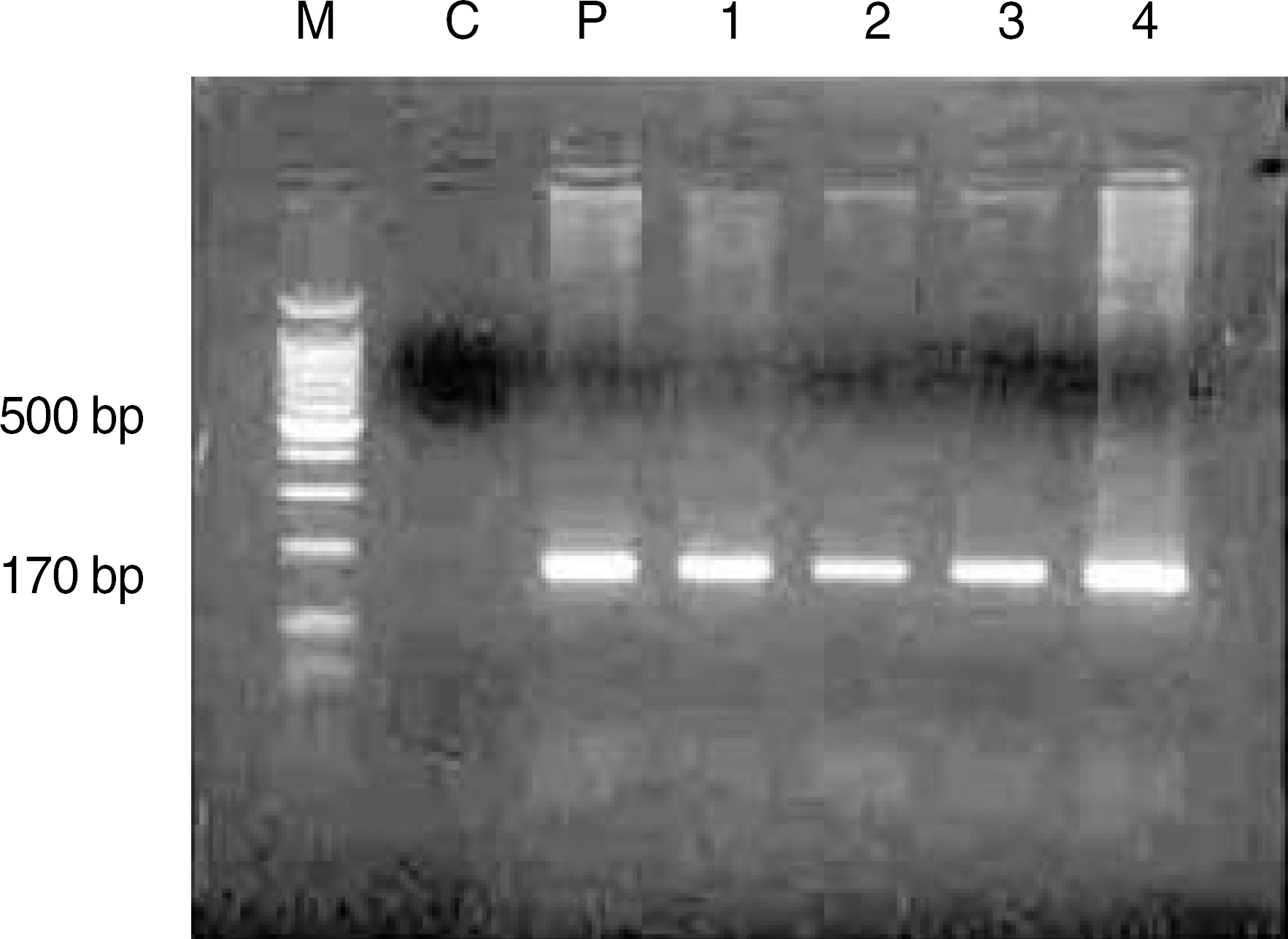Korean J Lab Med.
2006 Apr;26(2):131-136. 10.3343/kjlm.2006.26.2.131.
Identification of Y-chromosome by Molecular Analysis in Patients with Turner Syndrome
- Affiliations
-
- 1Department of Laboratory Medicine, Busan Paik Hospital, College of Medicine, Inje University, Busan, Korea. pk7146@hanmail.net
- 2Department of Pediatrics, Busan Paik Hospital, College of Medicine, Inje University, Busan, Korea.
- 3Paik Institute for Clinical Research, Busan Paik Hospital, College of Medicine, Inje University, Busan, Korea.
- KMID: 2238904
- DOI: http://doi.org/10.3343/kjlm.2006.26.2.131
Abstract
-
BACKGROUND: It is known that the Y chromosome or Y-specific sequence is present in about 6% of Turner syndrome (TS) patients and that it predisposes them to gonadoblastoma formation with an estimated risk of 15-25%. In this study, we performed a polymerase chain reaction (PCR) in 32 patients with TS to detect Y-specific sequence. The results were compared with those obtained by the fluorescence in situ hybridaization (FISH) method.
METHODS
Cytogenetic analysis was performed by phytohaemagglutinin (PHA)-stimulated peripheral lymphocyte cultures, using G-banding. DNA was extracted from peripheral blood for PCR. Seven different sets of oligonucleotide primers, sex determining region Y (SRY), zinc finger gene on the Y chromosome (ZFY), testis specific protein Y (TSPY), DYZ3, DYF49S1, RNA binding motif protein (RBM), and DYZ1, spanning on centromeres and short and long arms of the Y chromosome were used for PCR. FISH was carried out using X and Y chromosome enumeration probe for Xp11.1-q11.1 (DXZ1 locus) and Yp11.1-q11.1 (DYZ3 locus), respectively.
RESULTS
Among 32 patients with TS, four (12.5%) were positive for Y specific sequence by PCR. Of these, two patients were detected previously by a cytogenetic analysis: 45,X/47,XYY and 45,X/46,XY. Only one Y specific sequence, DYZ3, was detected by PCR in the other two patients without cytogenetically obvious Y chromosome. Y signal was not detected by FISH for the last two patients.
CONCLUSIONS
It may be reasonable to consider using a PCR method to screen for Y-specific sequences in all patients with TS. Even though we did not demonstrate Y-signal by FISH in patients with PCR positive and cytogenetically no obvious Y chromosome, FISH may be another useful method in TS patient, and futher investigation is nessessary.
Keyword
MeSH Terms
Figure
Reference
-
References
1. Ford CE, Jones KW, Polani PE, De Almeida JC, Briggs JH. A sex-chromosome anomaly in a case of gonadal dysgenesis (Turner's syndrome.). Lancet. 1959; 1:711–3.
Article2. Fernandez-Garcia R, Garcia-Doval S, Costoya S, Pasaro E. Analysis of sex chromosome aneuploidy in41 patients withTurner syndrome: a study of ‘hidden’ mosaicism. Clin Genet. 2000; 58:201–8.3. Jacobs P, Dalton P, James R, Mosse K, Power M, Robinson D, et al. Turner syndrome: a cytogenetic and molecularstudy. Ann Hum Genet. 1997; 61:471–83.4. Verp MS, Simpson JL. Abnormal sexual differentiation and neoplasia. Cancer Genet Cytogenet. 1987; 25:191–218.
Article5. Jang YW, Chun HJ, Kim EJ, Jeon DS, Kim JR, Lee YJ, et al. PCR-based analysis for Y-specific sequence in patients with Turner syndrome. Korean J Clin Pathol. 1998; 18:271–8.6. Yorifuji T, Muroi J, Mamada M, Uematsu A, Kawai M, Momoi T, et al. Analysis of the SRY gene in Turner syndrome patients with Y chromosomal material. J Med Genet. 2001; 38:E41.
Article7. Mendes JR, Strufaldi MW, Delcelo R, Moises RC, Vieira JG, Kasamatsu TS, et al. Y-chromosome identification by PCR and gonadal histopathology in Turner's syndrome without overt Y-mosaicism. Clin Endocrinol (Oxf). 1999; 50:19–26.
Article8. Patsalis PC, Sismani C, Hadjimarcou MI, Kitsiou-Tzeli S, Tzezou A, Hadjiathanasiou CG, et al. Detection and incidence of cryptic Y chromosome sequences in Turner syndrome patients. Clin Genet. 1998; 53:249–57.
Article9. Mitelman F, editor. An International System for Human Cytogenetic Nomenclature. Basel: Karger;1995.10. Troche V, Hernandez E. Neoplasia arising in dysgenetic gonads. Obstet Gynecol Surv. 1986; 41:74–9.
Article11. Medlej R, Lobaccaro JM, Berta P, Belon C, Leheup B, Toublanc JE, et al. Screening for Y-derived sex determining gene SRY in 40 patients with Turner syndrome. J Clin Endocrinol Metab. 1992; 75:1289–92.
Article12. Coto E, Toral JF, Menendez MJ, Hernando I, Plasencia A, Benavides A, et al. PCR-based study of the presence of Y-chromosome sequences in patients with Ullrich-Turner syndrome. Am J Med Genet. 1995; 57:393–6.
Article13. Binder G, Koch A, Wajs E, Ranke MB. Nested polymerase chain reaction study of 53 cases with Turner's syndrome: is cytogenetically undetected Y mosaicism common? J Clin Endocrinol Metab. 1995; 80:3532–6.
Article14. Quilter CR, Taylor K, Conway GS, Nathwani N, Delhanty JD. Cytogenetic and molecular investigations of Y chromosome sequences and their role in Turner syndrome. Ann Hum Genet. 1998; 62:99–106.
Article15. Page DC. Y chromosome sequences in Turner's syndrome and risk of gonadoblastomaor virilisation. Lancet. 1994; 343:240.16. Tsuchiya K, Reijo R, Page DC, Disteche CM. Gonadoblastoma: molecular definition of the susceptibility region on the Y chromosome. Am J Hum Genet. 1995; 57:1400–7.17. Yorifuji T, Muroi J, Kawai M, Sasaki H, Momoi T, Furusho K. PCR-based detection of mosaicism in Turner syndrome patients. Hum Genet. 1997; 99:62–5.
Article18. Alvarez-Nava F, Soto M, Martinez MC, Prieto M, Alvarez Z. FISH and PCR analyses in three patients with 45,X/46,X,idic(Y) karyotype: clinical and pathologic spectrum. Ann Genet. 2003; 46:443–8.19. Schwartz S, Depinet TW, Leana-Cox J, Isada NB, Karson EM, Park VM, et al. Sex chromosome markers: characterization using fluorescence in situ hybridization and review of the literature. Am J Med Genet. 1997; 71:1–7.
Article
- Full Text Links
- Actions
-
Cited
- CITED
-
- Close
- Share
- Similar articles
-
- Hidden Y Chromosome and Marker Chromosome Identification by FISH (Fluorescence in Situ Hybridization) in Turner Syndrome
- Molecular Genetic Screening for the SRY(Sex Determining Region of the Y chromosme) Gene in Turner Syndrome Patients
- A Case of mos 45,X/46,X, +mar. ish der(X)(wcpX+) Turner Syndrome
- Ovarian mixed germ cell tumor in a patient with 45,X/46,X,+mar mosaic Turner's syndrome
- A Case of Variants of Turner syndrome Showing 46,X,inv(Y)/45,X Karyotype with Y Chromosome microdeletion


